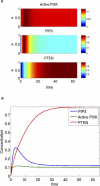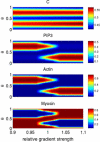A mathematical model for neutrophil gradient sensing and polarization
- PMID: 17367201
- PMCID: PMC1828701
- DOI: 10.1371/journal.pcbi.0030036
A mathematical model for neutrophil gradient sensing and polarization
Abstract
Directed cell migration in response to chemical cues, also known as chemotaxis, is an important physiological process involved in wound healing, foraging, and the immune response. Cell migration requires the simultaneous formation of actin polymers at the leading edge and actomyosin complexes at the sides and back of the cell. An unresolved question in eukaryotic chemotaxis is how the same chemoattractant signal determines both the cell's front and back. Recent experimental studies have begun to reveal the biochemical mechanisms necessary for this polarized cellular response. We propose a mathematical model of neutrophil gradient sensing and polarization based on experimentally characterized biochemical mechanisms. The model demonstrates that the known dynamics for Rho GTPase and phosphatidylinositol-3-kinase (PI3K) activation are sufficient for both gradient sensing and polarization. In particular, the model demonstrates that these mechanisms can correctly localize the "front" and "rear" pathways in response to both uniform concentrations and gradients of chemical attractants, including in actin-inhibited cells. Furthermore, the model predictions are robust to the values of many parameters. A key result of the model is the proposed coincidence circuit involving PI3K and Ras that obviates the need for the "global inhibitors" proposed, though never experimentally verified, in many previous mathematical models of eukaryotic chemotaxis. Finally, experiments are proposed to (in)validate this model and further our understanding of neutrophil chemotaxis.
Conflict of interest statement
Figures














Similar articles
-
Spontaneous polarization in eukaryotic gradient sensing: a mathematical model based on mutual inhibition of frontness and backness pathways.J Theor Biol. 2006 Jun 21;240(4):538-53. doi: 10.1016/j.jtbi.2005.10.022. Epub 2005 Dec 15. J Theor Biol. 2006. PMID: 16343548
-
The molecular genetics of chemotaxis: sensing and responding to chemoattractant gradients.Bioessays. 2000 Jul;22(7):603-15. doi: 10.1002/1521-1878(200007)22:7<603::AID-BIES3>3.0.CO;2-#. Bioessays. 2000. PMID: 10878573 Review.
-
Asymmetrical protein kinase A activity establishes neutrophil cytoskeletal polarity and enables chemotaxis.J Leukoc Biol. 2005 Jul;78(1):248-58. doi: 10.1189/jlb.0804459. Epub 2005 Apr 7. J Leukoc Biol. 2005. PMID: 15817703
-
Neutrophil migration under spatially-varying chemoattractant gradient profiles.Biomed Microdevices. 2015;17(3):9963. doi: 10.1007/s10544-015-9963-8. Biomed Microdevices. 2015. PMID: 25998723
-
Leading the way: Directional sensing through phosphatidylinositol 3-kinase and other signaling pathways.J Cell Sci. 2003 Sep 1;116(Pt 17):3471-8. doi: 10.1242/jcs.00703. J Cell Sci. 2003. PMID: 12893811 Review.
Cited by
-
Mathematical analysis of steady-state solutions in compartment and continuum models of cell polarization.Math Biosci Eng. 2011 Oct 1;8(4):1135-68. doi: 10.3934/mbe.2011.8.1135. Math Biosci Eng. 2011. PMID: 21936604 Free PMC article.
-
Mathematical Models for Immunology: Current State of the Art and Future Research Directions.Bull Math Biol. 2016 Oct;78(10):2091-2134. doi: 10.1007/s11538-016-0214-9. Epub 2016 Oct 6. Bull Math Biol. 2016. PMID: 27714570 Free PMC article. Review.
-
Autocatalytic loop, amplification and diffusion: a mathematical and computational model of cell polarization in neural chemotaxis.PLoS Comput Biol. 2009 Aug;5(8):e1000479. doi: 10.1371/journal.pcbi.1000479. Epub 2009 Aug 28. PLoS Comput Biol. 2009. PMID: 19714204 Free PMC article.
-
Two Complementary Signaling Pathways Depict Eukaryotic Chemotaxis: A Mechanochemical Coupling Model.Front Cell Dev Biol. 2021 Nov 17;9:786254. doi: 10.3389/fcell.2021.786254. eCollection 2021. Front Cell Dev Biol. 2021. PMID: 34869388 Free PMC article.
-
Model supports asymmetric regulation across the intercellular junction for collective cell polarization.PLoS Comput Biol. 2024 Dec 17;20(12):e1012216. doi: 10.1371/journal.pcbi.1012216. eCollection 2024 Dec. PLoS Comput Biol. 2024. PMID: 39689113 Free PMC article.
References
-
- Manahan C, Iglesias P, Long Y, Deverotes P. Chemoattractant signaling in dictyostelium discoideum. Annu Rev Cell Dev Biol. 2004;20:223–253. - PubMed
-
- van Haastert P, Devreotes P. Chemotaxis: Signalling the way forward. Nat Rev Mol Cell Biol. 2004;5:626–634. - PubMed
-
- Li S, Guan J, Chein S. Biochemistry and biomechanics of cell motility. Annu Rev Biomed Eng. 2005;7:105–150. - PubMed
-
- Schiffmann E. Leukocyte chemotaxis. Annu Rev Physiol. 1982;44:553–568. - PubMed
-
- Deverotes P, Zigmond S. Chemotaxis in eukaryotic cells: A focus on leukocytes and Dictyostelium . Annu Rev Cell Biol. 1988;4:649–686. - PubMed
Publication types
MeSH terms
Substances
LinkOut - more resources
Full Text Sources

